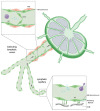Lymphatic Tissue Bioengineering for the Treatment of Postsurgical Lymphedema
- PMID: 35447722
- PMCID: PMC9025804
- DOI: 10.3390/bioengineering9040162
Lymphatic Tissue Bioengineering for the Treatment of Postsurgical Lymphedema
Abstract
Lymphedema is characterized by progressive and chronic tissue swelling and inflammation from local accumulation of interstitial fluid due to lymphatic injury or dysfunction. It is a debilitating condition that significantly impacts a patient's quality of life, and has limited treatment options. With better understanding of the molecular mechanisms and pathophysiology of lymphedema and advances in tissue engineering technologies, lymphatic tissue bioengineering and regeneration have emerged as a potential therapeutic option for postsurgical lymphedema. Various strategies involving stem cells, lymphangiogenic factors, bioengineered matrices and mechanical stimuli allow more precisely controlled regeneration of lymphatic tissue at the site of lymphedema without subjecting patients to complications or iatrogenic injuries associated with surgeries. This review provides an overview of current innovative approaches of lymphatic tissue bioengineering that represent a promising treatment option for postsurgical lymphedema.
Keywords: lymphangiogenesis; lymphatic regeneration; lymphatic tissue bioengineering; lymphedema; scaffolds; stem cells.
Conflict of interest statement
Cynthia J. Sung, Kshitij Gupta, and Jin Wang, have no conflict of interest. Alex K. Wong is the Founder of Lymphagen, Inc.
Figures


Similar articles
-
Tissue engineering approaches for lymphedema: biomaterial innovations and clinical potential.Front Cell Dev Biol. 2025 Apr 15;13:1537050. doi: 10.3389/fcell.2025.1537050. eCollection 2025. Front Cell Dev Biol. 2025. PMID: 40302939 Free PMC article. Review.
-
Engineering the Lymphatic Network: A Solution to Lymphedema.Adv Healthc Mater. 2021 Mar;10(6):e2001537. doi: 10.1002/adhm.202001537. Epub 2021 Jan 27. Adv Healthc Mater. 2021. PMID: 33502814 Free PMC article. Review.
-
Lymphatic Vessels in Regenerative Medicine and Tissue Engineering.Tissue Eng Part B Rev. 2016 Oct;22(5):395-407. doi: 10.1089/ten.TEB.2016.0034. Epub 2016 Jun 27. Tissue Eng Part B Rev. 2016. PMID: 27142568 Review.
-
Tissue Engineering Strategies for Cancer-Related Lymphedema.Tissue Eng Part A. 2021 Apr;27(7-8):489-499. doi: 10.1089/ten.TEA.2020.0378. Tissue Eng Part A. 2021. PMID: 33563108 Review.
-
Lymphatic endothelial cell RXRα is critical for 9-cis-retinoic acid-mediated lymphangiogenesis and prevention of secondary lymphedema.FASEB J. 2023 Jan;37(1):e22674. doi: 10.1096/fj.202200146RR. FASEB J. 2023. PMID: 36520015
Cited by
-
Tissue engineering approaches for lymphedema: biomaterial innovations and clinical potential.Front Cell Dev Biol. 2025 Apr 15;13:1537050. doi: 10.3389/fcell.2025.1537050. eCollection 2025. Front Cell Dev Biol. 2025. PMID: 40302939 Free PMC article. Review.
-
Assessment of the Efficiency of Measuring Foot and Ankle Edema with a 3D Portable Scanner.Bioengineering (Basel). 2023 May 3;10(5):549. doi: 10.3390/bioengineering10050549. Bioengineering (Basel). 2023. PMID: 37237619 Free PMC article.
-
Biomaterials in the clinical treatment of lymphedema-a systematic review.J Vasc Surg Venous Lymphat Disord. 2024 Jan;12(1):101676. doi: 10.1016/j.jvsv.2023.08.015. Epub 2023 Sep 9. J Vasc Surg Venous Lymphat Disord. 2024. PMID: 37696416 Free PMC article.
-
Therapeutic Potential of Cannabidiol Cyclodextrin Complex in Polymeric Micelle and Tetrahydrocurcumin Cyclodextrin Complex Loaded in Hydrogel to Treat Lymphedema.Int J Mol Sci. 2025 Apr 6;26(7):3428. doi: 10.3390/ijms26073428. Int J Mol Sci. 2025. PMID: 40244338 Free PMC article.
-
Recellularized lymph node scaffolds with human adipose-derived stem cells enhance lymph node regeneration to improve lymphedema.Sci Rep. 2023 Apr 3;13(1):5397. doi: 10.1038/s41598-023-32473-z. Sci Rep. 2023. PMID: 37012287 Free PMC article.
References
-
- Ozdowski L., Gupta V. Physiology, Lymphatic System. StatPearls Publishing; Treasure Island, FL, USA: 2022. [(accessed on 9 May 2021)]. Available online: https://www.ncbi.nlm.nih.gov/books/NBK557833/ - PubMed
-
- Huethorst E., Krebber M.M., Fledderus J.O., Gremmels H., Xu Y.J., Pei J., Verhaar M.C., Cheng C. Lymphatic Vascular Regeneration: The Next Step in Tissue Engineering. Tissue Eng. Part B Rev. 2016;22:1–14. - PubMed
-
- Wiig H., Swartz M.A. Interstitial fluid and lymph formation and transport: Physiological regulation and roles in inflammation and cancer. Physiol. Rev. 2012;92:1005–1060. - PubMed
-
- Hansen K.C., D’Alessandro A., Clement C., Santambrogio L. Lymph formation, composition and circulation: A proteomics perspective. Int. Immunol. 2015;27:219–227. - PubMed
-
- Tammela T., Alitalo K. Lymphangiogenesis: Molecular mechanisms and future promise. Cell. 2010;140:460–476. - PubMed
Publication types
Grants and funding
LinkOut - more resources
Full Text Sources

